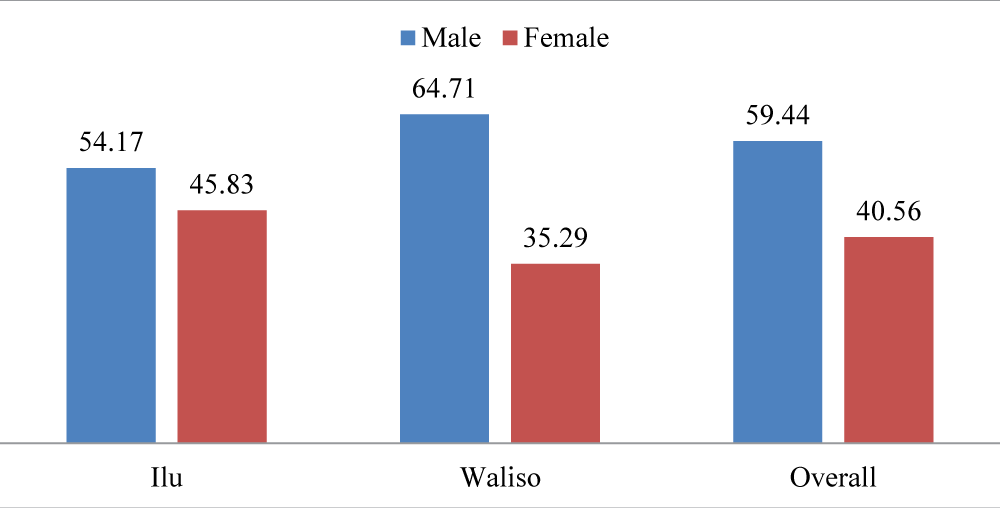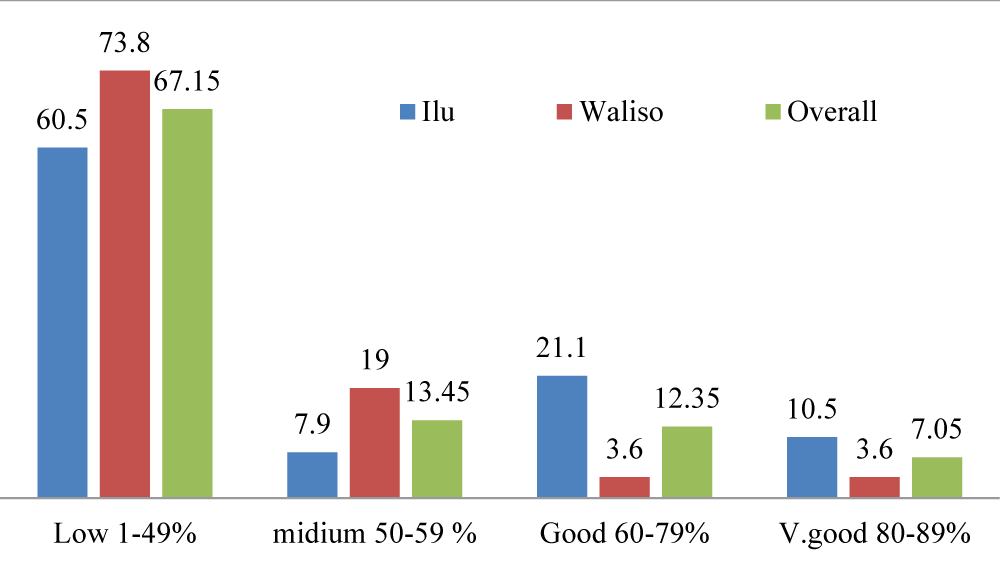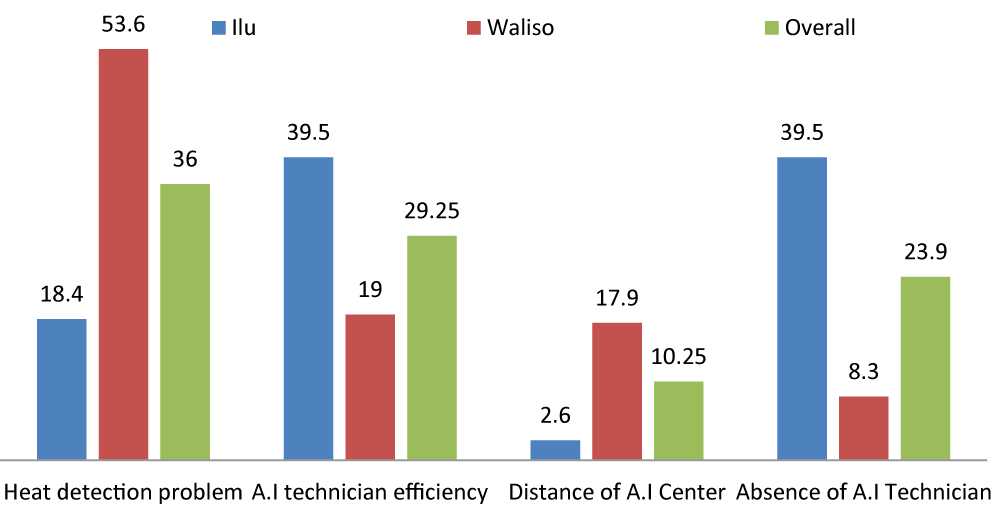More Information
Submitted: 17 February 2020 | Approved: 04 March 2020 | Published: 05 March 2020
How to cite this article: Fekata A, Galmessa U, Fita L, Merera C, Bekuma A. Dairy cattle producers’ perception on Oestrus Synchronization and mass artificial insemination services in Waliso and Ilu Districts of South West Shoa Zone of Oromia, Ethiopia. Insights Vet Sci. 2020; 4: 010-013.
DOI: 10.29328/journal.ivs.1001020
Copyright License: © 2020 Fekata A, et al. This is an open access article distributed under the Creative Commons Attribution License, which permits unrestricted use, distribution, and reproduction in any medium, provided the original work is properly cited.
Keywords: Perception; Synchronization; Mass Insemination; Ilu and Waliso; Ethiopia
Dairy cattle producers’ perception on Oestrus Synchronization and mass artificial insemination services in Waliso and Ilu Districts of South West Shoa Zone of Oromia, Ethiopia
Abera Fekata1*, Ulfina Galmessa2, Lemma Fita2, Chala Merera3 and Amanuel Bekuma4
1Department of Animal and Range science, Bule Hora Universty, Bule Hora, Ethiopia
2Ethiopian Institute of Agricultural Research (EIAR), Holeta, Ethiopia
3Department of Animal science, Ambo University, Ambo, Ethiopia
4Department of Animal Science, Mettu University, Bedele, Ethiopia
*Address for Correspondence: Abera Fekata, Department of Animal and Range science, Bule Hora Universty, Bule Hora, Ethiopia, Tel: +2519-10-04-39-82; Email: [email protected]
The study was conducted in Ilu and Waliso districs of South West Shoa Zone to investigate the perception of dairy cattle producers on oestrus synchronization and mass artificial insemination services. A total of 122 respondents (38 from Ilu and 84 from Waliso districts) owning at least one lactating cow and participated in synchronization program were randomly selected and interviewed individually by using semi- structured questionnaire. Both primary and secondary data were used to generate reliable information on the intended topic. All collected data were analyzed using SPSS statistical package version 20 and the output was presented by descriptive statistics such as percentage and mean values in inform of graphs. Most of the respondents (67.15%) indicated that their satisfaction level towards synchronization and mass artificial insemination was low. Only few of them reported being satisfied as (medium-13.45%, good - 12.35% and very good - 7.05%). This might be because of shortage of feed, silent heat, poor performance of the inseminator and low awareness of farmers on the technology. From the study it was also noted that the overall percentage (26.22%) of calving rate to oestrus synchronization and mass artificial insemination was low. This might be due to heat detection problem (36%); A.I technician efficiency (29.25%), absence of A.I technician (23.9%) and distance of A.I center (10.25%). Therefore, the skill and knowledge based training should be given for both the farmers and implementers to enhance perception and adoption of the technology.
The Ethiopia’s population, presently estimated to be 91 million, will jump to an estimated 278 million by midcentury (2050). To feed this population, current agricultural production from crops, livestock, fisheries and aquaculture should increase by over 60% [1]. On the other hand, of the total (60.39) million cattle population in Ethiopia, 1.54 percent (928,065) and 0.22 percent (135, 105) are hybrid and exotic breed, respectively. The remaining, 98.24 percent of the total cattle populations are local breeds [2] though the productivity of the native livestock is low due to their genetic makeup, low level of inputs, and traditional husbandry practice besides environmental stress [3-5]. However, the distribution of native livestock populations across the different agro-ecologies of the country provides various options for tangible and nontangible use of livestock products to the smallholder farmers and pastoral communities.
In order to improve the low genetic potential of local cattle in particular, selection of the most promising breeds and cross breeding of these indigenous breeds with highly productive exotic cattle has been considered as a practical solution [3]. In Ethiopia, artificial insemination had been going on for nearly fifty years. However, it is widely believed that the artificial insemination (AI) service in the country has not been successful to improve reproductive performance of dairy industry [6]. In conventional AI system, the pregnancy rate of dairy cattle to first insemination was found to be 27% [7], whereas in improved system it was found to be 39.3% [8].
Oromia is one of regional state in Ethiopia having low conception rate, which is 34.29 % [9]. In order to enhance efficiency of AI service and to solve heat detection problem, oestrus synchronization and mass artificial insemination is the best tool in areas where dairy development is feasible [10].
According to Azage, et al. [4], report awareness creation, proper training, careful animal selection (good body condition score, cows free from diseases and with functional ovaries), good animal handling facility at a convenient location, a well-trained, organized and motivated multi-disciplinary team (livestock science, feeds and nutrition experts, veterinarians, AI technicians, etc.) actively participant community and proper leadership and coordination are key elements for the success of synchronization program. Therefore, this study was designed to investigate the perception of dairy cattle producers on oestrus synchronization and mass artificial insemination services and to identify problems associated with this technology.
Descriptions of the study area
Ilu district: The district is located 59km from Zonal town Waliso. Its altitude ranges from 2060 to 2100m.a.s.l. and receives an annual rainfall of 700-800 mm. The mean minimum and maximum annual temperature of the district is 15 °C and 25 °C, respectively. The area covers 37,294 hectares total area of land. The area has midland agro-climate condition. The estimated cattle populations in the districts were 61,004 cattle (Ilu District Livestock and Fishery Resources Development Office (IDLFRDO), 2017) [11].
Waliso district: The district is located at 114 km from Addis Ababa and is the zonal capital city. Its altitude ranges from 1850 to 2800m.a.s.l and receives a mean minimum 1350 mm and 1600 mm mean minimum annual rainfall with the annual temperatures of 15 °C and 24 °C, respectively. It covers 78,366 hectares of land. It has two agro-ecologies (30% high land and 70% mid land). The estimated cattle population of the area is 224, 334 (Waliso District Agricultural Office (WDAO), 2017) [12].
Sampling techniques and tousehold selection
From the zonal districts, Ilu and Waliso districts were purposively selected based on accessibility and potential of dairy cattle population and estrous synchronization and mass artificial insemination (OSMAI) beneficiaries. Accordingly, two peasant Associations (PAs) Alango Tulu and Bill from Ilu District and four PAs, Obi Koji, Dambali Keta, Badessa Koricha and Tombe Ancabi from Waliso District were purposively selected. From each selected PAs, households which had participated on OSMAI at least once over the last two years were selected and interviewed. The representative sample size for households was determined by Yamane’s Formula [13] as follow:
n = N
1+N (e)2
Where:
n = sample size
N = total number of households
e = Sampling error at 92%
1 = probability of the event occurring
Based on the formula, totally 122 households were selected for the study to represent the zone.
Data types and collection methods
Both primary and secondary data sources were used. Primary data was gathered through two approaches namely semi-structured questionnaire and group discussions. The questionnaire was translated to local language (Afan Oromo) to make easily understandable and pre-tested before administration and some re-arrangement, reframing and correction was made in accordance with respondent perception. The questionnaires were administered to households by enumerators recruited and trained for the purpose, with close supervision by the researchers. Based on the questionnaire, perception of the dairy cattle owners about OSMAI program, factors affecting success of synchronization program, and available opportunities were collected. In addition, information was collected from group discussions. A group discussion was organized in villages of two districts with purposely selected youngsters, women, village leaders, developmental agents (DAs), artificial insemination technicians (AITs) and socially respected individuals who are known to have better knowledge on the present and past social and economic status of the area. Group discussions was focused on the history of the breeding practices of dairy cows, utility pattern of the dairy cows and OSMAI services, current status and major constraints of the OSMAI practices and services.
Data analysis
Statistical Package for Social Sciences software version 20 (SPSS Inc., Chicago, IL, USA) was used to conduct all the statistical analyses.
Oestrus synchronization and mass Artificial insemination status
The overall performance of oestrus synchronization and mass artificial insemination in the present study area were presented in figure 1. It was noted that the overall percentage of calving rate to oestrus synchronization and mass insemination was 26.22%. This finding is in line with the result (26.8%) reported by Tewodros, et al. [14], in Fogera Woreda of North-Western Ethiopia. In contrary with the current finding, different response rate was reported in different part of the country, Azage, et al. [4], who reported 57.7% in Hawassa-Dale milk shade and Bainesagn [15] who reported 28%) in west showa zone, Oromia.
Figure 1: Sex and status of calve born by oestrus synchronization and A.I.
Sex of calves
The percentage of male and female calves born in the present study were (59.44%) and (40.56%), respectively (Figure 1). This current finding was similar with the value (60% and 40%) reported by Tewodros, et al. [14], for male and female, respectively in Fogera Woreda of North-Western Ethiopia. The majority of calves born in the current study area were male calves. However, the respondents were preferred to have female heifers for replacement stock. Even though 50:50 calves born sex ratio of male and female was reported by Ismudiono [16,17], in the present study area sex of male calves’ percentage was greater than that of female sex calves percentage. This makes as the farmers always complain against artificial insemination. This might be due to the activation of Y-chromosome higher than the X-chromosome so that it travels fast through the reproductive tract and able to fertilize in the oviduct.
Farmer’s perception toward synchronization in the study area
According to focus group discussion and key informant interview, in the study areas farmers’ perception towards Oestrus synchronization technology was highly determined by calf born achieved rather than by the rate of response to hormone treatment. Majority (67.15%) of oestrus synchronization beneficiaries had low perception towards synchronization and mass artificial insemination; few of them satisfied as medium (13.45%), good (12.35%) and very good (7.05) (Figure 2). This lower satisfaction level in the current study was greater than 54.7% and 42.9%) reported by Destalem [7] in Tigray region, and by Bainesagn [15] in Oromia regional state of East shoa zone, respectively. The main reasons for poor perception of dairy cattle farmers towards estrus synchronization and mass artificial insemination in the study areas might be due to wrong procedures used in the campaign and false report without doing necessary conditions at grass root level.
Figure 2: Farmers perception toward synchronization in the study area.
Constraints and Opportunity related to synchronization
Constraints: The major constraints related to oestrus synchronization and mass insemination in Ilu and Waliso districts was presented in figure 3. Accordingly, heat detection problem (36%), A.I technician efficiency (29.25%), absence of A.I technician (23.9%) and distance of A.I center (10.25%) were reported as the major constraints of low performance toward synchronization and AI, in their order of importance. It was also noted that there was difference in the magnitude of each problem in the two districts. For example, where improper heat detection was mentioned as the major constraints (53.6%) in Ilu district, absence of A.I technician and their efficiency was reported as the main problem (39.5%) in Waliso district. Besides, these major constraints, in appropriate season of breeding (being planned during scarcity period (i.e. January, February and March), silent heat, poor management, lack of awareness, emaciated dairy cows selected for oestrus synchronization program, distance of AI center from the dairy farmers, and limited number of A.I technician assigned at each district were also reported as the constraints of low performances to synchronization technology. The present results was in line with result reported by Destalem, [7], in central zone of Tigray region, were poor heat detection, communication and transport problems that hamper timely insemination, poor semen quality, lack of incentives and inefficiency of AI technicians as the major constraints of synchronization and AI.
Figure 3: The common constraints of oestrus synchronization and A.I.
Opportunities: Even though paramount constraints are hampering the success of oestrus synchronization and mass artificial insemination in the study areas, presence of hormones for synchronization, veterinary service and experts, availability of cattle population, interest of farmers, good market demand for milk production were among the opportunities listed by the respondents related to oestrus synchronization and mass artificial insemination. The current finding is similar to the result reported by Destalem [7] in central zone of Tigray region, Northern Ethiopia.
As revealed by results of this study, the status of synchronization and mass artificial insemination and farmers’ perception towards the technology was low. This might be due to heat detection problem (discrepancy between time of heat that dairy cattle owners report to AITs and appropriate time of insemination), poor A.I technician efficiency, and absence of A.I technician and distance of A.I center. Based on the above conclusion, the following recommendations are forwarded:
🔴 Future breeding activities should consider knowledge and perception of farmers to improve breeding practice of dairy cattle in West shoa Zone.
🔴 Good management system in terms of reproductive health management, feeding and housing should be considered before implementing effective estrous synchronization and mass artificial insemination program.
🔴 The skill and knowledge based training for enhancement estrus synchronization must be given for both the farmers and implementers to enhance perception and adoption of the technology.
The authors are greatly thankful to Ambo University for providing permission and support. The author appreciates the support and understanding of Ilu and Waliso districts farmers involved in dairy production. Our especial thank has goes to the staff of Livestock and Fishery Resources development Office of Ilu and Waliso Districts.
- Food and Agriculture Organization (FAO). The State of World Fisheries and Aquaculture. FAO Fisheries and Aquaculture Department, Food and Agriculture Organization of the United Nations Rome. 2014.
- Central Statistical Agency (CSA). Federal Democratic Republic of Ethiopia, Agricultural Sample Survey, Volume II, Report On Livestock And Livestock Characteristics (Private Peasant Holdings). Statistical bulletin, 587, April 2018, Addis Ababa, Ethiopia. 2018.
- Tadesse B. Calf Sex Ratios in Artificially Inseminated and Natural Mated Female Crossbred Dairy Herd. In: Proceedings of the 13 annual Conference of the Ethiopian Society of Animal Production. Addis Ababa, Ethiopia. 2008; 227.
- Tegegne A, Estifanos A, Tera A, Hoekstra D.. Technological Options and Approaches to Improve Smallholder Access to Desirable Animal Genetic Material for Dairy Development: IPMS (Improving Productivity and Market Success) Experience with Hormonal Oestrus Synchronization and Mass Insemination in Ethiopia. “Resilience of agricultural systems against crises” Göttingen. 2012.
- Ahmed S, Mohammed A, Nuraddis I, Misganu A. Perception of Dairy Cattle Owners on Oestrus Synchronization and Mass Artificial Insemination Services in Jimma Zone, South Western Ethiopia. Greener J Agri Sci. 2017; 7: 137-144.
- Sinishaw W. Study on Semen Quality and Field Efficiency of AI Bulls Kept at The National Artificial Insemination Center. MSc thesis, Addis Ababa University, Faculty of veterinary Medicine, Debre Zeit. Ethiopia. 2005; 13-17.
- Gebremedhin D. Assessment of Problems / Constraints Associated with Artificial insemination service in Ethiopia. M.Sc. Thesis. Addis Ababa University Faculty of veterinary medicine, Debre Zeit, Ethiopia. 2008.
- Gizaw S, Tesfaye Y, Mekuriaw Z, Tadesse M, Hoekstra D, et al. Oestrus Synchronization for Accelerated Delivery of Improved Dairy Genetics In Ethiopia: Results From Action Research And Development Interventions. LIVES Working Paper 12. Nairobi, Kenya: International Livestock Research Institute (ILRI). 2016.
- Legesse D. Assessment of breeding practices and evaluation of mass estrus synchronization of dairy cattle in sidama zone, southern Ethiopia. MSc. thesis, department of animal and range science, Hawassa University, Ethiopia. Journal of Natural Sciences Research, 2015; 6.
- Tegegne A, Warnick AC, Mukasa Mugerwa E, Ketema H. Fertility of Bos Indicus and Bos Indicus X Bos Taurus Crossbred Cattle after Oestrus Synchronization. Theriogenology. 1989; 31: 361-370. PubMed: https://www.ncbi.nlm.nih.gov/pubmed/16726556
- Ilu District Livestock and Fishery Resources Development Office (IDLFRDO), 2017.
- Waliso District Livestock and Fishery Resources Development Office (WDLFRDO) 2017.
- Yamane, Taro. Statistics: An Introductory Analysis, 2nd Edition, New York: Harper and Row. 1967.
- Alemneh T, Mogess W, Marew G, Adera Z.. Study on the Conception Rate of Dairy Cows Artificially Inseminated During Natural Heat and By Synchronization in Fogera Woreda, North-West of Ethiopia. Faculty of Veterinary Medicine, University of Gondar, P.O. Box: 196.Ethiopia. African Journal of Basic & Applied Sciences. 2015; 7: 291-297.
- Bainesagn W. Assesment of breeding practices and evaluation of estrus synchronization and mass insemination technique in dairy cattle in West Shoa zone. Msc thesis, Haramaya University, Ethiopia. 2015.
- Husni I, dan Pudji Srianto A. Upaya Meningkatkan Angka Kebuntingan Melalui Inseminasi Ganda dalam Program Penyerentak Birahi pada Sapi Perah. Lembaga Penelitian Universitas Airlangga. 2000.
- Debir Legesse 2015. Assessment of breeding practices and evaluation of mass estrus synchronization of dairy cattle in sidama zone, southern Ethiopia. MSc. thesis, department of animal and range science, Hawassa University, Ethiopia. J Na Sci Res. 2016; 6.


